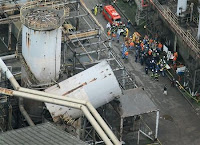
A dust explosion can be deadly. The sugar dust explosion at Imperial Sugar Industries, Port Wentworth, Georgia, USA in 2008 killed 11 people and injured 42 workers, some of them critically. Dust explosions have known to occur as far back as the 18
th century when a baker reported an explosion in a flour warehouse.
Most organic materials and many metals will burn or explode if they are finely divided and dispersed in air and contact an ignition source. Dust explosions have occurred in a many industries including flour, coal, aluminum, plastic, vitamins, pharmaceutical compounds, sugar, tea, corn starch etc.A normal fire triangle consists of fuel, oxygen and ignition source. However for a dust explosion to occur, two additional elements are required – dispersion of the combustible dust in air in a concentration sufficient to ignite and confinement.Hence for a dust explosion to occur, the following are needed:
1. Fuel
2. Air (oxygen)
3. Ignition source
4. Dispersion of combustible dust
5. Confinement (The confinement causes and explosion to occur)
The above 5 elements needed for a dust explosion to occur are called a dust explosion pentagon.
The damage from a dust explosion is catastrophic because the primary dust explosion causes the loose dust present in beams and on top of other equipment to shake loose and fall down. This causes a secondary explosion which is far more deadly than the first one. Thus the domino effect of the primary dust explosion can be carried forward through elevators, conveyors and silos. The result is a catastrophic explosion. NFPA 654 states that dust layers 1/32 inch thick can create hazardous conditions.
The Material Safety Data Sheets for many substances do not indicate the potential for dust explosions. Many organisations implement changes that inadvertently create an atmosphere for a dust explosion. Enclosing an open conveyor is one such change. The Chemical Safety Board of the USA has recorded 197 incidents involving dust explosions since 1980, with 109 fatalities and 592 injuries.
Preventing dust explosions:
To prevent a dust explosion, it is necessary to eliminate the fuel (combustible dust), oxygen or ignition source.
While complete elimination of the fuel (combustible dust) may not be possible, it is possible to eliminate the chance of a secondary explosion by proper training and housekeeping. Dust collectors must be maintained properly to avoid a drop in their collection efficiency. Another method is to add an inert material like rock dust into the combustible dust.
Complete removal of oxygen is also not possible in a system comprising of conveyors, elevators, bins and silos. Inerting (use of an inert gas) also brings along safety issues of asphyxiation of personnel.
Eliminating all sources of ignition may also not be possible. Normal sources of ignition include the following:
- Hot bearings and surfaces
- Static electricity
- Hot work (welding, cutting, brazing or spark producing activity)
- Electrical system including faulty equipment
Mitigating dust explosions:
Effective mitigation requires properly designed engineering solutions. These solutions include explosion venting, explosion suppression and explosion isolation.
Explosion Venting
Explosion vents are designed to direct the gases from a dust explosion to a safe location and prevent over pressurization and damaging the equipment. The location of the vent should be placed in such a way as not to harm personnel.
Explosion Suppression
An explosion suppression system consists of a pressure or temperature sensor that detects the start of a dust explosion and a chemical suppression or inerting system that is automatically activated when the start of an explosion is detected. The chemical suppression or inerting system cools or extinguishes the flame front before it can cause damage.
Explosion Isolation
The explosion isolation systems work on the principle of detecting a dust explosion early and isolating long sections of pipelines leading to the protected equipment. A fast acting valve is used to isolate the protected equipment. The explosion venting systems are not suitable for dusts that burn quickly as the flame front speed will be high in such cases.

